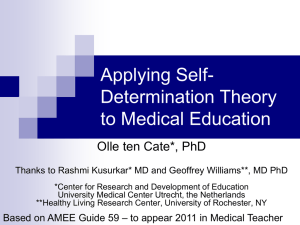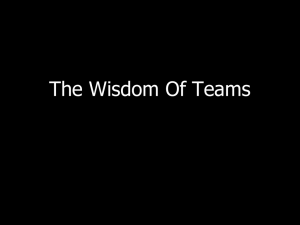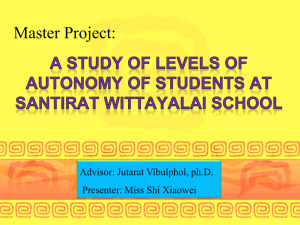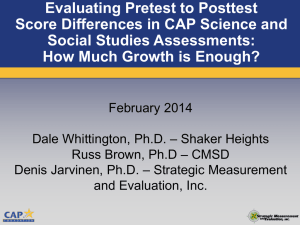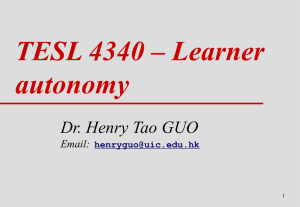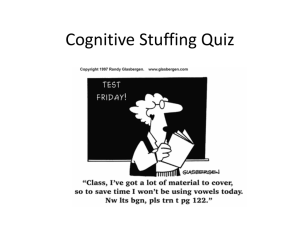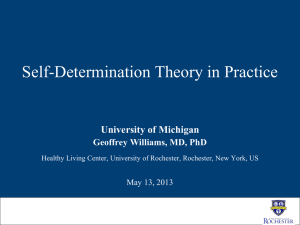Leen Haerens - Physical Literacy
advertisement
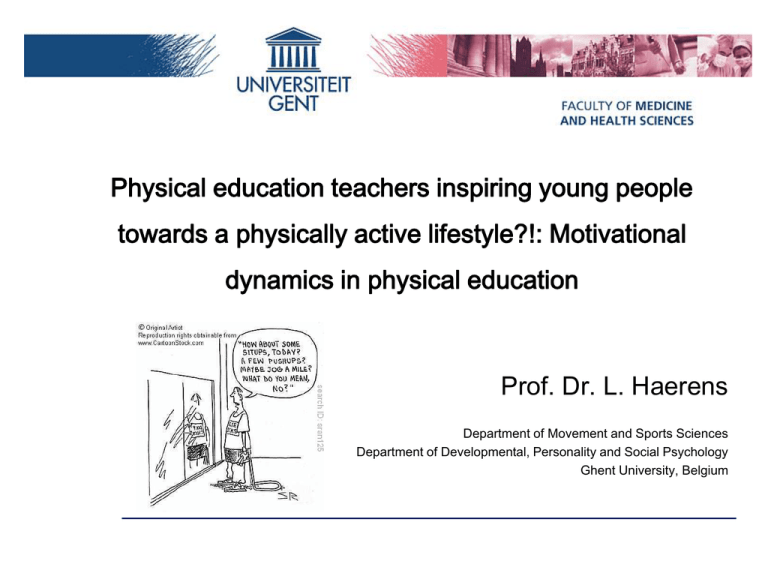
Physical education teachers inspiring young people towards a physically active lifestyle?!: Motivational dynamics in physical education Prof. Dr. L. Haerens Department of Movement and Sports Sciences Department of Developmental, Personality and Social Psychology Ghent University, Belgium Department of Movement and Sports Sciences (Ugent) Leen Haerens PHDstudents Greet Cardon Isabel Tallir Department of developmental, personal and social psychology (Ugent) Maarten Vansteenkiste Bart Soenens 1. PART I: Teaching for health based physical education: what does it mean? 2. PART II: Training teachers for health based physical education PART I: Teaching for health based physical education: what does it mean? Objectives 1. Stimulate evidence-based reflective thinking on the most appropriate content and pedagogy for health-based physical education (HBPE) 2. Providing an overview of Self-determination Theory and linking its key principles to HBPE One of the stated aims of all compulsory PE programmes is to educate for lifelong engagement in physical activity for health (Puhse & Gerber, 2005) BUT • PE = ‘the pill not taken’ (McKenzie & Lounsbery, 2009) • Lack of evidence on effective content and pedagogies for HBPE (Haerens et al, 2011) Question 1: Is Increasing MVPA during PE THE WAY to promote lifelong engagement in PA?! Is it really?.... Elementary schools 14 min MVPA 19 min MVPA Secondary schools => 20 min MVPA => 9 min MVPA 1.Increasing MVPA during PE insufficient for health (e.g. Harris, 2000, Cardon et al, 2004, Aelterman et al, 2010) 1. Need to promote transfer! 2. PE has a wide range of learning goals that are all important Question 2: Ok, but what’s the alternative? What is HBPE? =getting youngsters to value and enjoy physical activity for life so that they are (autonomously) motivated to become/remain active outside physical education Question 3: Motivation, what is it? SELF-DETERMINATION THEORY Prof. Edward Deci (University of Rochester, NY) Prof. Richard Ryan (University of Rochester, NY) I’m going to be put effort into PE... ‘because my teachers will punish me otherwise’ ‘because I can only be proud of myself if I do so’ Punishment rewards expectation s Shame, guilt, self-worth ‘because I feel more energetic afterwards’ ‘because I like PE’ ‘because I want to be healthy’ Personal relevance, meaningful Controlled motivation Mustivation Process of internalisation = ownership of change Pleasure, passion, interest Autonomous motivation Volitional motivation What is HBPE? =getting youngsters to value and enjoy physical activity for life so that they are autonomously motivated to become/remain active outside physical education Question 4: Is motivation really an important concept to consider in the relationship between PE and PA? What’s the evidence? • Increased physical activity during PE (Aelterman et al, 2012) • Remain more active in leisure time (Haerens et al, 2010) AUTONOMOUS MOTIVATION Question 5: How do we teach for optimal motivation? Self-Determination Theory (Deci & Ryan, 1985; 2000) Autonomy Competence Relatedness AUTONOMY SUPPORT STRUCTURE RELATEDNESS SUPPORT - Sincere interest - Choice - Meaningful rationale - Minimizing controlling language - Fun elements - Optimal challenge - Positive feedback - Encouragement - Clear guidelines & expectations - Sincere concern - Warmth - Unconditional regard - Emotional support Cox et al., 2008; Jang, Reeve & Deci, 2010; Mouratidis et al., 2008; Reeve & Jang, 2006; Sheldon & Filak, 2008; Vansteenkiste et al., 2004 Self-determination theory (Deci & Ryan, 1985; 2000) TEACHER STUDENT Need-support Need satisfaction Autonomy-support Structure Involvement Autonomy Competence Relatedness Perceptions of need-support Motivation Outcome Teacher benchmarks for HBPE? Increasing autonomy support: e.g. providing choice Providing structure and competence support: e.g. help, differentiation Relatedness support: e.g. being sincerely concerned about your pupils Question 6: Does teachers’ need support really leads to more autonomous motivation and higher activity levels. What’s the evidence? STUDIE 4 6a: Is need support notified by the students? TEACHER STUDENT ? Need-support Need satisfaction Autonomy-support Structure Involvement Autonomy Competence Relatedness Perceptions of need-support Motivation Outcome E.g. The teacher asks the students questions about their interests, problems, values or wishes • “Which exercises do you find hard to do?” • “Did you understand the instructions?” E.g. The teacher provides a rationale for guidelines, tasks and assignments. • “A wider foot position is important because it enhances your balance.” E.g. The teacher takes the perspective of students into account, is empathic. • “The teacher simplifies his language depending on the students’ development” Autonomysupport Structure Involvement + + + Autonomysupport Structure Involvement STUDIE 4 6a: Is need support notified by the students? TEACHER STUDENT ? Need-support Need satisfaction Autonomy-support Structure Involvement Autonomy Competence Relatedness Perceptions of need-support Yes it is! Motivation Outcome 6b: Does need support lead to more optimal outcomes? TEACHER Need-support Autonomy-support Structure Involvement STUDENT Perceptions of need-support Need satisfaction Autonomous motivation Activity levels Study 1 (Belgium) Physical activity during PE: accelerometers (CSA Actigraph monitors) Study 2 (UK) Transfer of learning => to what extent does PE stimulates you to become more active during leisure time NEED-SUPPORTIVE TEACHING BEHAVIOR Autonomy support Structure Involvement MVPA during PE Model has good fit! χ2 =2,295, df=2 RMSEA=0.012 CFI=1 SRMR=0.008 Full mediation! χ2 =446.20, df=85 RMSEA=0.066 CFI=0,96 SRMR=0.049 STUDENTS’ NEED SATISFACTION Autonomy-relatedness Competence MVPA during PE χ2 =84,24, df=18 RMSEA=0.062 CFI=0,98 SRMR=0.022 Only partical mediation, direct relationship remains significant χ2 =185,163, df=49 RMSEA=0.054 CFI=0,99 SRMR=0.024 Methods Study 2 Multilevel Regression analyses (MLWin) Methods Study 2 Multilevel Regression analyses (MLWin) • Both studies point towards the importance of need support and need satisfaction • Enhancing perceived competence might be crucial! Teachers’ need support! Actual motor competence? What is HBPE in secondary schools? =getting youngsters to value and enjoy physical activity for life so that they are (autonomously) motivated to become/remain active outside physical education What is HBPE in preschool and elementary schools? =providing young children with the necessary FMS to be able to feel competent when engaging in physical activities and sports in secondary schools and in later life? The Bright Side of Self-determination Theory (Deci & Ryan, 1985; 2000) NEED-SUPPORTIVE CONTEXTS Autonomy support Structure Involvement NEED SATISFACTION Autonomy Competence Relatedness AUTONOMOUS MOTIVATION Positive outcomes Question 7: What about the Dark side of Selfdetermination Theory? (Deci & Ryan, 1985; 2000) NEED-THWARTING CONTEXT Controlling Chaotic Cold NEED FRUSTRATION Autonomy Competence Relatedness Autonomous motivation Controlled motivation Amotivation Negative outcomes Introduction Autonomy Autonomy AUTONOMY SUPPORT CONTROL - Sincere interest - Choice - Meaningful rationale - promoting initiative - Fun elements -Shouting, yelling, roaring -Exerting power -Losing patience -Controlling language -Pressuring pupils -Criticizing pupils Autonomy support i.e. ‘’ Lisa is there something wrong? I see you are struggeling with catching the ball. If you want that I show it again, you can ask me.’’ Controlling i.e. ‘‘ Come on Dean, just throw and catch (irritated). A boy of your age schould be able to do this naturally. NO, NO, NO, … STOP, NOT GOOD, come over here,… ’’ Controlled motivation c-path B = .43 (0.20)* a-path B = .41 (0.19)* CONTROLLED MOTIVATION b-path BL2 = .60 (0.10)*** PERCEIVED CONTROLLING BL1 = .66 (0.04)*** Indirect effect = 0.25 (0.12)* De Meyer J.*, Tallir I.*, Soenens B., Vansteenkiste M., Speleers L., Aelterman N., Van den Berghe L. & Haerens L. (Accepted pending minor revisisons). Relation between observed controlling teaching behavior and students’ motivation in physical education. Journal of Educational Psychology. *Equal contribution Amotivation c-path B = .23 (0.21) a-path B = .41 (0.19)* AMOTIVATION b-path BL2 = .54 (0.12)*** PERCEIVED CONTROLLING BL1 = .67 (0.05)*** Indirect effect = 0.22 (0.11)* De Meyer J.*, Tallir I.*, Soenens B., Vansteenkiste M., Speleers L., Aelterman N., Van den Berghe L. & Haerens L. (Accepted pending minor revisisons). Relation between observed controlling teaching behavior and students’ motivation in physical education. Journal of Educational Psychology. *Equal contribution Although teachers do not engage often in controlling behavior students do notice Controlling teaching behavior is related to less optimal forms of motivation Controlled motivation and amotivation are related with lower levels of PA in and outside PE (Aelterman et al., 2012 and Haerens et al. 2010) 41 PART I: Teaching for health based physical education: what does it mean? Conclusion Conclusion WHAT IS HBPE IN SECONDARY SCHOOLS? Teaching for youngsters to be more likely to value and enjoy physical activity for life so that they become/remain active outside physical education TEACHERS NEED TO BE STIMULATED TO TEACH IN A MORE NEED SUPPORTIVE & LESS CONTROLLING WAY! INTERVENTIONS/CPD FOR TEACHERS NEEDED! PART I: Teaching for health based physical education: what does it mean? Objectives 1. Stimulate evidence-based reflective thinking on the most appropriate content and pedagogy for health-based physical education (HBPE) 2. Providing an overview of Self-determination Theory and linking its key principles to HBPE 1. PART I: Teaching for health based physical education: what does it mean? 2. PART II: Training teachers for health based physical education: what is needed? Intervention and experimental studies needed Better insight into antecedents of teachers’ behaviors 1. Antecedents of need supportive and need thwarting teaching behaviors? General causality orientation = The source of initiation and regulation of behavior in daily life. E.g., you are asked to plan a picnic for yourself and your fellow employees. Your style for approaching this project could most likely be characterized as: … A. Seek participation: get inputs from others before you make the final plans. Autonomy Orientation B. Take charge: that is, you would make most of the major Controlled Orientation decisions yourself. Autonomy support Structure before activity Need Support Structure during activity Relatedness support Control Controlled Orientation Need Thwarting Chaos Cold interactions Antecedents Above Within Need support / thwarting Below Need to explore a wider range of antecedents in order to be able to design effective interventions for teachers! 2. Development of a theory driven intervention for PE teachers Intervention need-supportive teaching style (Aelterman et al., 2013) Content: one-day training: 3 parts • Part I: Theoretical background principles SDT • Partl II: Overview of motivating/need-supportive teaching strategies illustrated by case studies and video images Autonomy-support Structure Relatedness-support • Partl III: Application exercise Method of delivery ‧ ‘Teach as you preach’ Aelterman, N., Vansteenkiste, M. Van Keer, H., De Meyer, J., Van den Berghe, L., & Haerens, L. (2013). Development and evaluation of a training on need-supportive teaching in physical education: Qualitative and quantitative findings. Teaching and Teacher Education . Well, I think we can learn the most from autonomy-support. Structure we are already quite familiar with. ‘You could start from a couple of concrete class situations to introduce the different strategies’ ‘Maybe you can ask the audience for concrete examples from their practical experience?’ Theoretical framing is essential Autonomy-supportive strategies are more innovative and useful Opportunities for interactive discussion and reflection Application exercises: microteaching and role-playing Teach as you preach! (= congruent teaching) Theoretical framing is always important. Without this information, I don’t really think you know what you’re doing. ‘I think it would be more fun to do a practical session in the gym.’ ‘Wouldn’t it be interesting to have four different lesson plans to start from?’ ‘If the training would have taken till 4 o’clock pm, there would have been a good balance between theory and practice.’ Revisions 1 Part I: Theoretical background After Training I - Reduction in number of slides - Deletion of non-essential content After Training II - No changes After Training III - Development of a pocket-sized booklet of the handouts in which solutions are omitted and space is provided to write down the answers and/or personal thoughts Part II: Overview of motivating strategies After Training I - Reversing the order of presentation of the strategies from Autonomy support-Structure to StructureAutonomy support - Addition of video-images used as ‘bad practices’ After Training II - Reduction in number of practical examples to increase the input from the audience - Starting from a ‘case’ to introduce a strategy in order to improve the interaction with and between the PE teachers After Training III - Subdivision of the strategies in very concrete and useful guidelines - Increase in the number of case studies to stimulate active participation and self-reflection - Provision of concrete tools as teaching aids - Repeatedly underlining the link between the specific guidelines and the basic psychological needs Part III: Application exercise After Training I - From paper-and-pencil exercise to role play and microteaching in the gymnasium - Extension of the duration of Part III from 30 minutes to one hour - From one topic (volleyball) to different topics (basketball, gymnastics, rope skipping) After Training II - From feedback by the trainer to feedback by fellow PE teachers After Training III - Extension of the duration to an entire day - From feedback by fellow PE teachers to selfreflection - Group discussion to share ideas and voice concerns and obstacles on how to implement the strategies in class Illustration: Part 2 of the intervention Providing autonomy support HINT 1: Stimulating initiative Question: ‣ How does the teacher stimulates his pupils to take initiative? Fragment 2: ‣ ‣ ‣ ‣ ‣ 6 years of teaching experience; Baseball Girls Vocational education Final year of secondary school HINT 1a: Try to integrate choice into your lessons to stimulate pupils to take initiative Situation Although children can not always choose the topic of the lesson or the exerices themselves, there is still a possibility to incorporate choice into your lesson. In a series of lessons on handstand the teachers wants to provide opportunities for choice, how would you provide choice in such a lesson? Evolution in global appreciation of the training 4 3.9 3.8 3.7 3.6 3.5 3.4 Global appreciation Workshop 1 3.61 Workshop 2 3.8 Workshop 3 3.97 3. Is the intervention effective? METHOD Sample 39 PE teachers out of 19 different schools (79.5% men; M age= 38.51 ± 10.44 years) 669 students (63.4% boys; M age = 14.58 ± 1.92 years) Design T1 Intervention N = 15 Random assignment Control N = 24 T2 WS 1 Pretest Intervention Posttest WS 2 Pretest Intervention Posttest Pretest Posttest Aelterman, N., Vansteenkiste, M., Van den Berghe, L., De Meyer, J., & Haerens, L. (in preparation). Multi-informant effects of an intervention on need-supportive teaching in physical education. Outcomes Effective “Proximal” outcomes “Distal” outcomes Beliefs Behavior Feasible Teacher Student Observer Intervention effects on teachers’ perceived effectiveness of autonomy-support and structure Autonomy-support 4.3 4.2 4.1 4 3.9 3.8 3.7 3.6 Control group Intervention group Structure 4.2 4.1 4 3.9 3.8 Pretest 4.24 3.86 Posttest 4.13 4.1 ES = .12 3.7 Control group Intervention group Pretest 4.01 3.83 ES = .11 Posttest 3.92 4.09 Intervention effects on teachers’ perceived feasibility of autonomy-support and structure Autonomy-support 3.9 3.8 3.7 3.6 3.5 3.4 3.3 Control group Intervention group Pretest 3.87 3.49 Posttest 3.84 3.76 ES = .11 Structure 4 3.9 3.8 3.7 3.6 3.5 3.4 3.3 3.2 Control group Intervention group Pretest 3.79 3.47 Posttest 3.85 3.92 ES = .14 Intervention effects on teachers’ autonomy-support ES = .06 Teacher-reported autonomy-support Observed autonomy-support 3.8 3.7 3.6 3.5 3.4 3.3 3.2 0.5 Control group Intervention group 0.4 ES = .24 0.3 0.2 0.1 Pretest 3.74 3.39 0 Posttest 3.73 3.66 Control group Intervention group Student perceived autonomysupport β = .06 3.5 3.4 3.3 3.2 3.1 3 Control Intervention Pretest 3.28 3.31 Posttest 3.18 3.39 Pretest 0.28 0.22 Posttest 0.24 0.46 Three informants Teacher Belief Behavior Effective Feasible Autonomysupport Structure Autonomysupport Structure Structure Student Observer Behavior Behavior Autonomysupport Autonomy-support Relatedness support Autonomous motivation to apply the strategies .32** Need satisfaction training -.21* .36** Controlled motivation to apply the strategies ns Intention to apply the strategies -.22* -.27* Defiance toward change Aelterman, N., Vansteenkiste, M., Van den Berghe, L., De Meyer, J., & Haerens, L. (in preparation). Multi-informant effects of an intervention on need-supportive teaching in physical education. Training teachers for health based physical education: what is needed? Conclusion • Antecedents of teaching behaviors?! • Collaborate with experienced PE teachers in terms of research. • TEACH AS YOU PREACH • Authenticity to the message by maximizing PE teachers’ opportunities for basic psychological need satisfaction What’s next? Ongoing projects building on this work 1. Exploring motivational dynamics in vocational education 2. Motivating role of after school sport programs 3. How to translate SDT’s ideas towards motivational assessment? 4. Exploring the interplay between actual and perceived competence 5. Investigating reasons for non-engagment, defiance Thanks to you for your interest in our work! Thanks to all collaborating researchers for their input for this presentation!



